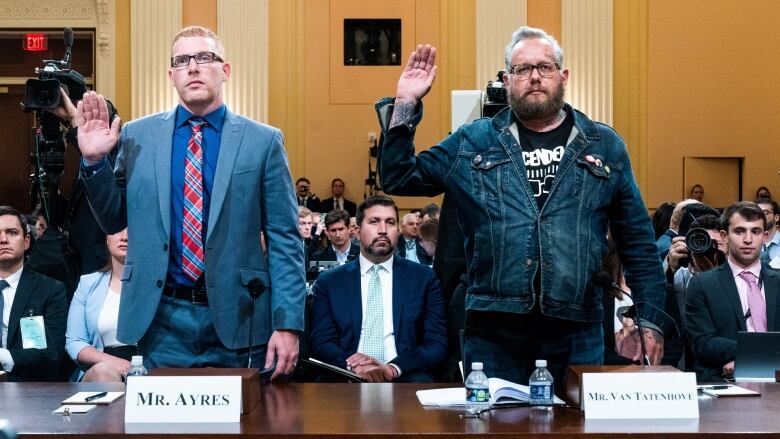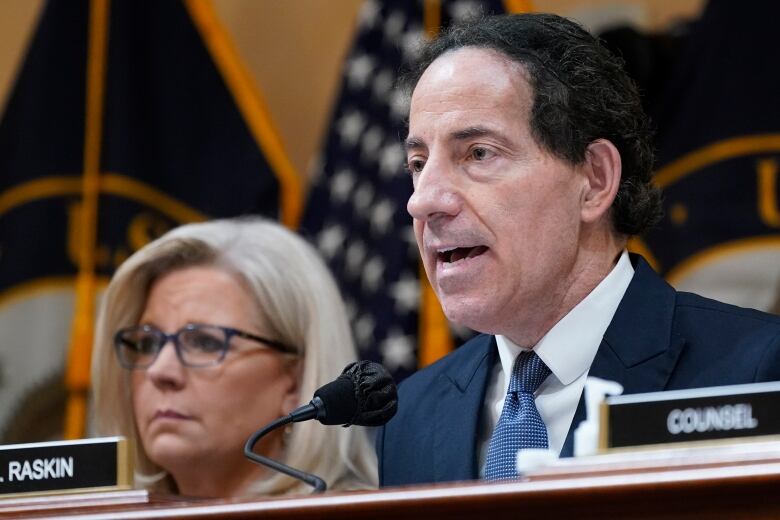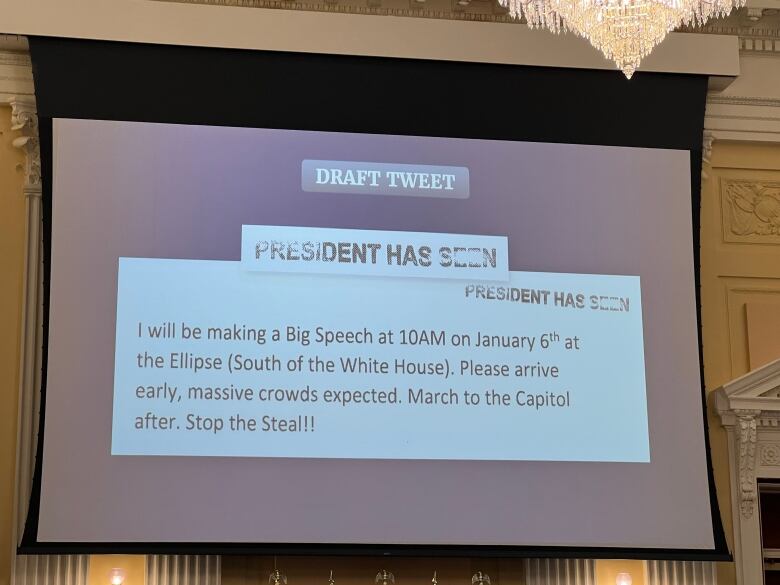Inspiration but no clear co-ordination between Trump and Oath Keepers, Proud Boys, Jan. 6 hearing suggests
Tying former president to seditious conspiracy would require more evidence, expert says

Tuesday's instalment of the congressional hearings into the events of Jan. 6, 2021, introduced evidence that former U.S. president Donald Trump and his advisers talked about amarch on the U.S. Capitol days in advance and that some of those who eventually turned up were paying close attention.
But itdid not necessarily show the kind of explicit co-ordination between Trump and the more militant groups that came to Washington armed and determined to stop the certification of the 2020 election results that some had been anticipating.
The House committee investigating the Capitol riot showed, through social media posts, that Trump was rallying his supporters to Washington for the Jan. 6 certification as early as Dec. 19.
Agitated by a fractious late-night meeting in which advisers argued over whether and how to overturn the election without sufficient evidence of fraud, Trump sent an early-morning tweetpromising the Jan. 6 rally "will be wild."
"Just hours after President Trump's tweet, Kelly Meggs, the head of the Florida Oath Keepers, declared an alliance among the Oath Keepers, the Proud Boys and the Florida Three Percenters, another militia group," committee member Jamie Raskin said.

"We have decided to work together and shut this shit down," Meggs had writtenon Facebook, the committee said.
By early January, some of the organizers of Trump's Jan. 6 rally on the grounds south of the White House known as theEllipsehad gotten wind he was planning to urge supporters to march to the Capitolbut was keeping that quiet.
"POTUS is going to just call for it, quote, unexpectedly," one organizer wrote in a text message Jan. 4.

Ali Alexander, head of the Stop the Steal organization, whichhad been amplifying Trump's false claims that the Democrats had stolen the 2020 election, also learned of the plan, texting a journalist on Jan. 5: "Trump is supposed to order us to the Capitol at the end of his speech, but we will see."
All of that, said Democratic Rep. Stephanie Murphy, who led Tuesday's hearing along with Rep.Raskin, "confirms that this was not a spontaneous call to action, but rather was a deliberate strategy decided upon in advance by the president."

No 'specific agreement' to act
But showing that the strategy was an effort co-ordinated with two of the high-profile groups whose leaders, along with several members, have been charged with seditious conspiracy in connection with the riot will be more difficult, says Barbara McQuade, a former U.S. attorney for the Eastern District of Michigan and a frequent commentator on legal matters.
"What we still don't have is a specific agreement between the Proud Boys and the Oath Keepers and somebody in the Trump inner circle saying, 'Yeah this is the plan. We're going to go breach the Capitol, and we're going to be sure they don't certify that vote,'"she said."I would think that if they had the evidence, they would have shown it by now."
The committee said it obtained encrypted chats that showed members of the two groups communicating with Trump allies RogerStone and Michael Flynn about rallies contestingelection results and making security arrangements on Jan. 5 and 6.But those did not reveal communications explicitly co-ordinating actions at the Capitol.

Stone and Flynn have associated with the groups in the past and used their members as security on several occasions, including, in Stone's case, the night of Jan. 5 at a rally near the White House. Itgot Trump's attention and included speakers whose rhetoric Trump's aides had considered too extreme for his Jan. 6 rally, according to witness testimony played Tuesday.
Several Trump aides recounted on video how Trump ordered staff to open the Oval Office doors so he could hear the rally, where Stone spoke of the "epic struggle between dark and light" and Flynn, Trump's former national security adviser, vowed that "we will not stand for a lie."

While Trump may have been energized by the protesters who descended on Washington on Jan. 6 to agitate for his cause and even riled them up himself, that does not necessarily amount to incitement, McQuade said.
"I think what the defence would be is, yes, he wanted to summon people to come to Washington to demonstrate their outrage, but he certainly did not tell them to break down the doors or hurt anybody physically, and they did that on their own," she said, pointing out that Trump even used the word "peacefully" in his Jan. 6 speech.
WATCH | Trump knew rallygoers had weapons, Jan. 6 committee hears:
'I was hanging on every word'
Stephen Ayres was one of the people convinced by Trump's claims about election fraud.
"I was hanging on every word he was saying," the Ohio mantestified at the hearing Tuesday. "Everything he was putting out, I was following it. I mean, if I was doing it, hundreds of thousands or millions of other people are doing it."
Ayres hadn't planned on going from the rallyto the Capitol, he testified Tuesday, until Trump urged supporters to do so.
He joined the crowd storming the doors and left only once Trump tweeted telling rioters to leave several hours after they entered. Ayrespleaded guilty last month to disorderly and disruptive conduct in a restricted building and will be sentenced in the fall.
WATCH | Capitol riotertestifies at Jan. 6 committee hearing:
Ayres's testimony "shows the kind of power [Trump] had over the people that were there," McQuade said. But according to Randall Eliason, a former federal prosecutor who teaches white collar criminal law at George Washington University Law School, proving a co-ordinated conspiracy will come down to intent.
"In these cases, intent is everything," he said. "You basically know what happened, and you know who did it, for the most part, so the question all comes down to state of mind did he actually have criminal intent? Was he really trying to inspire this kind of assault on the Capitol?"

Trump gave Oath Keepers 'the nod': witness
Rep. Murphy argued Tuesday that revisions and ad lib additions Trump made to the speech he delivered at the Ellipse made it more inflammatoryand "devolved into a call to action and a call to fight."
But Sam Jackson, who wrote a book on the Oath Keepers and studies far-right extremism in the U.S., says the group has a history of giving members autonomy and didn't need Trump to tell them what to do.
"An explicit connection with the Trump administration and some type of co-ordination for the day, thatwould be a really big deal but I don't think that's necessary for Oath Keepers to engage in the kind of activity that we saw," said Jackson, who teaches at the University of Albany's College of Emergency Preparedness, Homeland Security and Cybersecurity.
"They are the kind of people who would decide for themselves, 'We're going to do this because we think it's right, regardless of whether our man in the Oval Office explicitly told us to do it.'"

Jason Van Tatenhove, who worked as a spokesperson for the Oath Keepers from 2014 to 2016, testified Tuesday thatthe group's leader, Stewart Rhodes, who is in jail awaiting trial, was looking for legitimacy from Trump.
"The fact that the president was communicating, whether directly or indirectly messaging, you know, kind of that gave him the nod," Van Tatenhove said."They saw opportunity, I think, in my opinion, to become a paramilitary force."
CBC's request for an interview with Kellye SoRelle, an attorney who has acted as general counsel for the Oath Keepers, was not returned by the time of publication.
No strangers to politics
Jackson said both groups already had ties to conventional politics before the events leading up to Jan. 6.
"Oath Keepers for sure sees itself as a civic organization and sort of rejects the extremist label," he said. "They've had ties to the Tea Party, and they have encouraged their members to run for different political offices."
Most people who came to the Capitol were not members of either group, Rep. Raskin said, but like Ayres, viewed themas being aligned with Trump's cause of overturning what they saw as fraudulent election results.
WATCH | Day 7 of Jan. 6 hearing turns to extremist groups:
"I definitely didn't have a problem [rallying with them]," Ayres said. "I was probably following them online myself. I thought, hey, they're on our team good.'"
Jackson said that lines up with what he calls the group's "strategic ambiguity."
"It'll try to position itself really broadly, describing its members as patriots and saying that it's fighting against tyranny and for freedom and liberty and things like that. But the group sort of doesn't define what those terms mean."
'He could call off the mob'
People on both sides of the fight at the Capitol that day backed the notion that Trump's words had impact on what was unfolding.
Capitol Police Sgt. Aquilino Gonell, who was injured while trying to stop the rioters from entering the west tunnel entrance and has had to retire from policing, said he blames Trump for what happened to him and for not calling in the National Guard or other backup.

"He could call off the mob; instead, he egged them [on]. And that's pretty much when the fighting got even worse for me, for my fellow officers," Gonell, who got an apology from Ayres at Tuesday's hearing, told CBC News.
"People became more antagonized and more desperate to beat us up. And they did."
Larry Sabato, director of the Center for Politics at the University of Virginia in Charlottesville, says even if Tuesday's hearing didn't show explicit co-ordination, it advanced the Democrats' case that the rioters had the president's tacit approval.
"They'vebeen very careful not to suggest that they had written information there would be no emails going back and forth from Trump and his key aidesto the Proud Boys and the Oath Keepers," he said.
"I thought overall, it did push the case forward. They're leading to what Trump didn't do on Jan. 6, and that is clearly a violation of his presidential oath [to] faithfully execute the laws."
The blow-by-blow of what Trump did and didn't do in the more than three hours it took him to send the tweet that convinced Ayres and other rioters to leave the Capitol will be the focus of next week's hearing.















_(720p).jpg)


 OFFICIAL HD MUSIC VIDEO.jpg)
.jpg)



























































































